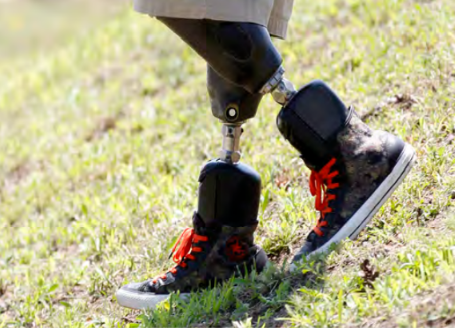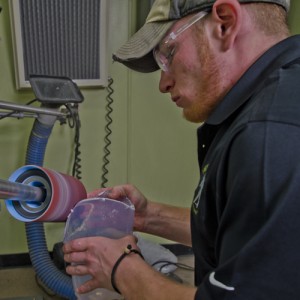MCOP Blog
Insights from our prosthetists about new technology, advances in prosthetics, & more
An Overview of Prosthetic Liner Types, Benefits & More
September 30, 2019Prosthetic Supplies Spotlight: A Helpful Overview of Prosthetic Liners
“Liners are the foundation of a comfortable and effective prosthetic.”
We originally wrote these words back in 2014, but they’re just as relevant today as they were then – if not more so. With all the new prosthetic technologies, advancements, and other strides that have been made between then and now, virtually every aspect of the industry has improved in some way, shape, or form – and prosthetic liners are no exception.
Here, we’ll review everything you could ever have to ask about these essential prosthetic supplies. Let’s get started!
What is the primary function of prosthetic liners?
The prosthetic liner acts as an interface that goes between a person’s skin and his or her prosthetic. In short, it’s a barrier – one that is applied to the skin before the prosthesis to protect the wearer’s skin while enhancing comfort and maintaining a more consistent fit.
Not all amputees have to wear a liner, but in our experience, we’ve found that most prefer to.
Prosthetic Liner Categories: TPE Liners, Silicone Liners & Urethane Liners
When it comes to the different types of prosthetic liners, there are three main types. To keep them separate, it helps to think of them in terms of a) the level of softness they provide, and b) the level of durability they provide.
Here, we’ll review these three different types, starting with softest/least durable and making our way to the hardest/most durable prosthetic liner types.
TPE Liners
The TPE liner (short for thermoplastic elastomer liner) is very soft and, in many ways, forgiving. That is, it’s perfectly suited for particularly sensitive and/or newer amputees. It’s also ideal for individuals who aren’t very active and are just looking for comfort.
However, the softness of the TPE liner also leads to some drawbacks. For example, since it is so soft, the gels that hold the liner together typically don’t last as long as the more durable options.
Silicone Liners
The silicone liner can be thought of as the middle-of-the-road liner as far as softness and durability are concerned. This type of liner retains some of the softness of the TPE liner, but also provides a bit more durability akin to urethane liners (more on those soon).
While still relatively soft, silicone liners aren’t as soft as TPE liners, making them more viable options for people who are a bit more active and need prosthetic supplies that are a bit more durable.
Urethane Liners
The least soft of the three liner types, the urethane liner provides users with what’s known as flow properties – that is, a unique ability that enables the liner’s gel to flow away from high-pressure areas, leading to a more balanced distribution of pressure and, subsequently, a more even fit.
Urethane liners are frequently used in prosthetics with vacuum sockets, and while they’re not the softest liners, their unique flow properties make them ideal for high-activity wearers who need a balance of durability and adaptability.
What’s the typical lifespan of prosthetic liners?
Long answer: it varies on a case-by-case basis, and there are a number of variables which can impact the rate of replacement. However, replacement generally takes place every six months for all three categories of liners, and it’s rarely shorter than six months between replacements. Conversely, it’s rare for a liner to last longer than a year and a half.
Short answer: generally no less than six months, but rarely more than 18 months.
Some extra info on prosthetic liner lifespans…
One of the things MCOP does to help our clients’ prosthetic liners last longer is give them not one, but two liners at a time. This allows customers to swap them out as needed, which many find to be a great convenience. Among other things, being able to switch between two different liners reduces the stress on the products since neither one has to be worn 24/7.
“There’s really nothing else that we have to wear all day, every day,” explains Brittany Mott, one of our Prosthetist- Orthotists at our Annapolis location. “Plus, liners aren’t especially breathable, and they take a lot of impact as a barrier between your skin and your socket.” This is one of the reasons why we always provide our clients with not one, but two sets of liners, which increases the shelf life of both.
What prosthetic technologies have made an impact on prosthetic liners?
As far as the impact of prosthetic technologies on prosthetic liners, we have to address suspension! In the prosthetic industry, suspension refers to the manner in which a particular prosthetic or device stays on a limb.
Suspension Options: Pin Lock Sockets or Vacuum Sockets?
As far as suspension methods, there are a few approaches. Many companies use pin locks, metal apparatuses that connect to a lock within the socket. These pin locks are convenient because they generate a very distinct clicking noise once the lock engages, making them convenient for older clients and other customers who need an easier system to ensure their devices stay equipped and in place.
We certainly understand the merit of the pin lock system, and we certainly won’t hesitate to provide a prosthetic device with a pin lock to a customer who needs it. However, the majority of our prosthetists are big advocates of vacuum sockets for a number of reasons.
For all intents and purposes, vacuum sockets are the same liners as pin lock liners; the only difference is that they lack a pin connection. In place of that pin is a much softer bottom, which helps to eliminate air from the system that can lead to discomfort and leads to a more “natural” feeling wear.
However, vacuum sockets do take a few more steps to apply than their pin lock counterparts, so they’re not for everyone. Still, they’re great for active amputees who need an airtight grip that leads to less socket movement, all without the burden of a tiny pin lock that’s constantly being pulled back and forth during more strenuous activities. Vacuum sockets also come in a wide variety of materials, providing potential wearers with more options based on their unique needs, hobbies, and lifestyle types.
So, as you can see, pin lock sockets and vacuum sockets both have their own unique features that customers can assess before making any decision. Thanks to the many advancements in prosthetic technologies throughout the past decade, we now have a bigger variety of options to offer our customers than ever before!
What prosthetic liner brands and product types can you get from MCOP?
It’s safe to say that our most popular prosthetic liner is the one developed by the massive Icelandic company, and prosthetic industry titan, Össur. However, there are some other big-name brands that offer up their own share of unique liners.
For example, Ottobock is the only other company besides Össur that creates a seal-in liner, which is a specialized and very durable silicone liner for transfemoral vacuum socket fittings.
The Ohio-based company WillowWood also produces some very popular liners.
All three of these companies produce quality liners made with general shapes, but when we come across an amputee with unique needs at one of our MCOP facilities, we generally turn to either Ottobock or WillowWood to create custom liners.
While WillowWood makes liners custom in the sense of where the gel goes, Ottobock makes custom liners out of urethane. When working with Ottobock to create custom liners, we’ll send them a cast of the person’s limb, then, weeks later we’ll receive an identical copy of what that limb looks like in the form of a custom liner.
Of course, custom liners aren’t the norm, but just like so many other things in the prosthetic field, everything must be analyzed and accounted for on a case-by-case basis.
How do I go about getting the prosthetic liner that’s right for me?
As a general rule, any prosthetic supplies that our clients want and/or require must first be approved by a doctor or physician. That doctor or physician will need to write up a prescription for the device or accessory (or, in this case, the liner) so that the client can then receive it.
At MCOP, we’re always happy to guide our clients in the right direction, and will provide recommendations for liners following first meeting, a regular checkup, or after an accident or incident that leaves the customer in need of a new device. Over the years, we’ve found that many doctors and physicians look to us with a high degree of trust to provide these recommendations, and our team is always available to help you figure out any insurance or billing-related issues you might encounter.
If you have any other questions regarding prosthetic liner types, benefits, or anything else related to these or other prosthetic supplies, don’t hesitate to contact us today!


